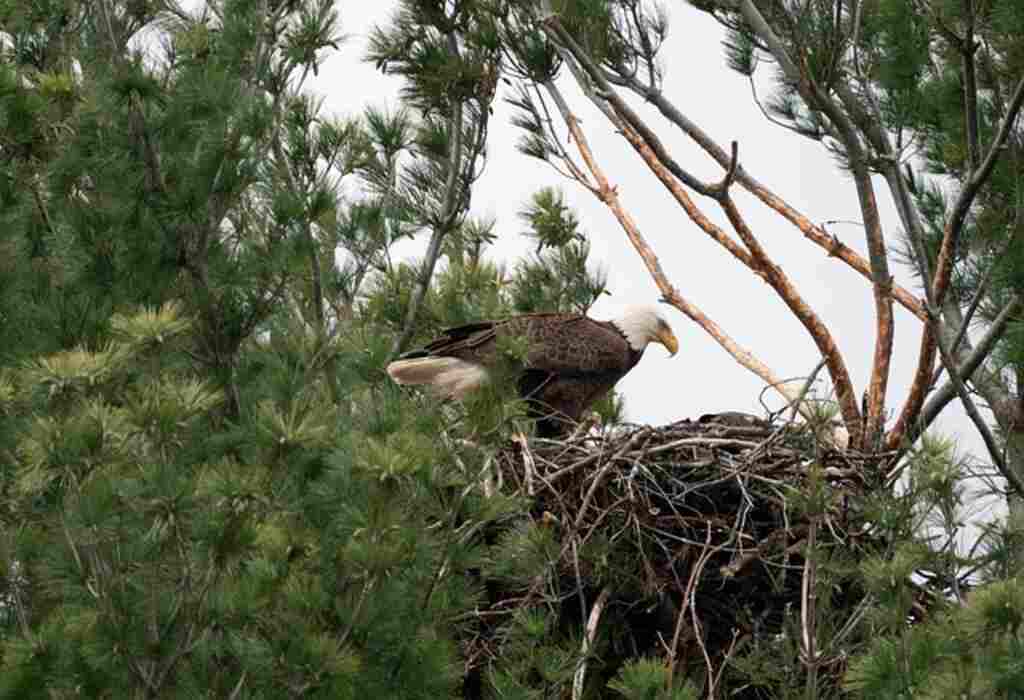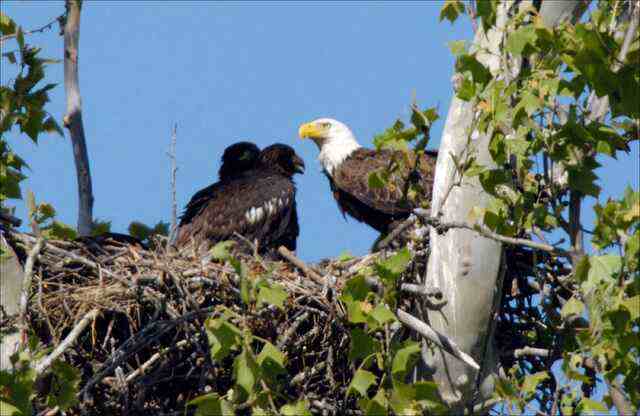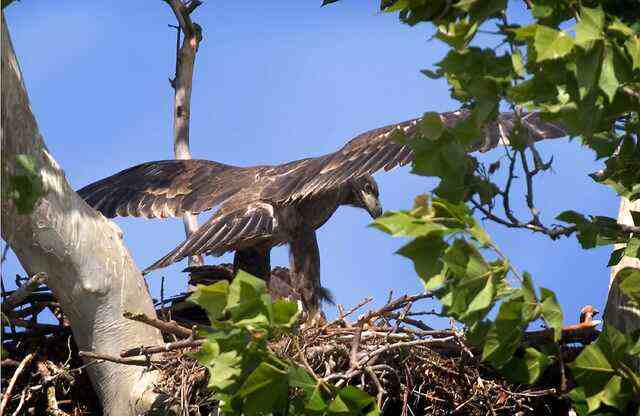Ironically, the epitome of freedom and majesty lies in the feeding habits of eagles. As these regal creatures soar with unparalleled grace, their devotion to nurturing their young captivates us. When do eagles stop feeding their young?
To answer this, we delve into the intricate life cycle of eagle fledglings, exploring stages of development and factors influencing parental feeding cessation.
Nesting and early growth set the foundation for independence. Sibling dynamics and competition play crucial roles, as does juvenile dispersal.
Understanding feeding cessation is vital for eagle survival. In this article, we unveil the fascinating world of eagle parenting, shedding light on conservation efforts and ensuring the prosperity of these awe-inspiring creatures.
Table of Contents
- 1 Key Takeaways
- 2 When Do Eagles Stop Feeding Their Young
- 3 The Life Cycle of Eagle Fledglings
- 4 Nesting and Early Development
- 5 Growth and Learning
- 6 Gradual Independence
- 7 Factors Affecting Parental Feeding Cessation
- 8 Observing the Transition
- 9 Challenges Faced by Fledglings
- 10 Sibling Dynamics and Competition
- 11 The Role of Juvenile Dispersal
- 12 Long-term Survival and Reproduction
- 13 Conservation Efforts and Future Research
- 14 Frequently Asked Questions
- 14.1 How long does it take for eagle fledglings to become fully independent?
- 14.2 Do eagle parents continue to feed their young after they leave the nest?
- 14.3 What factors determine when eagle parents stop feeding their young?
- 14.4 How do eagle fledglings learn to hunt and catch their own prey?
- 14.5 Are there any conservation efforts in place to protect eagle fledglings and their habitats?
- 15 Author
Key Takeaways
- Feeding cessation timing is important for the long-term survival and reproduction of eagles.
- Sibling interactions play a crucial role in the development of hunting techniques in fledglings.
- Factors affecting parental feeding cessation include age and physical readiness of the young eagles.
- Prey availability influences when parents stop providing food to their young.
When Do Eagles Stop Feeding Their Young
Eagles typically stop feeding their young when they reach a certain level of maturity and self-sufficiency. The timing varies among different eagle species and environmental factors.
After the nesting and early developmental stages, young eagles start developing independence and hunting skills.
Sibling competition and the availability of prey also influence the feeding cessation.
As eagles reach a point of self-reliance, parents gradually reduce their feeding, encouraging the fledglings to explore and hone their abilities.
Understanding this crucial phase in eagle parenting aids in their conservation and ensures their continued survival in the wild.
The Life Cycle of Eagle Fledglings
The life cycle of eagle fledglings encompasses the period in which they transition from being dependent on their parents for food to becoming self-sufficient hunters.
During this stage, sibling interactions play a crucial role in the development of hunting techniques.
Fledglings engage in playful activities that simulate hunting, such as chasing each other and practicing aerial maneuvers.
These interactions not only strengthen their bond but also help them acquire the necessary skills for successful hunting.
As they grow, fledglings gradually start to venture away from the nest in search of their own food.
Initially, they rely on their parents to provide them with prey, but as they become more proficient, they begin to catch their own meals.
This transition marks a significant milestone in their development, as they become capable of sustaining themselves without parental assistance.
Transitioning from dependence to independence, the next section will explore their nesting and early development.
Nesting and Early Development
Nesting and early development of eagles involves a crucial phase when the provision of sustenance for the offspring ceases. During this period, eagle parents focus on nest building and ensuring the structural integrity of the nest.
The nest is carefully constructed with sticks, grass, and other materials, providing a safe and secure environment for the young eagles.
Sibling interactions play a significant role during this time, as they learn important social and survival skills through play and competition.
These interactions help the fledglings develop their physical strength, coordination, and problem-solving abilities.
As the nest building and early development phase comes to an end, the eaglets undergo a transition towards growth and learning, where they begin to explore their surroundings and acquire essential hunting and flying skills.
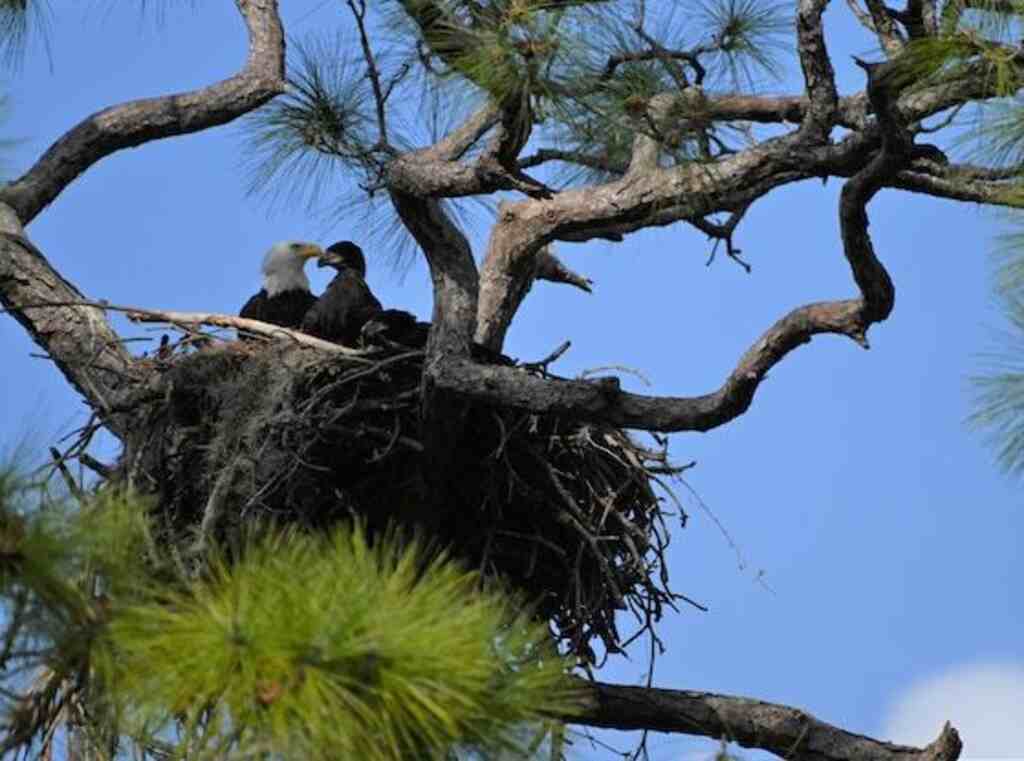
Growth and Learning
During the phase of growth and learning, young eagles undergo a transformative journey as they explore their surroundings, develop essential hunting and flying skills, and acquire the knowledge necessary for their future survival.
Social interaction plays a crucial role in their cognitive development, allowing them to learn from their parents and peers.
Through observing and imitating adult eagles, the young ones learn how to effectively communicate, hunt, and navigate their environment.
These interactions also foster the development of their problem-solving abilities and decision-making skills.
As the eaglets grow, they gradually gain independence, spreading their wings and soaring higher each day.
This gradual transition prepares them for a life of self-sufficiency, where they will eventually leave their parents’ nest and establish their own territories, contributing to the perpetuation of the eagle population.
Gradual Independence
This subtopic explores the process of gradual independence in eagles, specifically focusing on two key points: self-feeding and exploration of the surrounding territory.
Self-feeding refers to the development of the young eagle’s ability to hunt and provide for itself, gradually reducing its reliance on its parents for food.
This process is crucial for the young eagle’s growth and development, as it allows them to gain the necessary skills and experience for survival in the wild.
Additionally, the exploration of the surrounding territory enables the young eagle to expand its knowledge of the environment, learn to navigate and find suitable habitats, and ultimately become more independent in its ability to survive.
Introduction to Self-Feeding
Feeding their young independently is an important stage in the development of eagles. During this phase, eaglets begin to learn and practice self-feeding techniques, gradually reducing their reliance on parental feeding behavior.
This transition is crucial for their survival and future independence. Eaglets observe their parents’ hunting strategies, learning to identify suitable prey and develop hunting skills.
They experiment with different feeding techniques, such as tearing flesh or using their beaks to extract meat from bones.
Eaglets also learn to regulate their food intake, understanding when they are full and when to stop eating.
This introduction to self-feeding allows eaglets to acquire the necessary skills and knowledge to sustain themselves in the wild.
As they become more proficient in feeding independently, eaglets gain the confidence and competence to explore the surrounding territory, marking the next stage in their development.
Exploration of Surrounding Territory
After the initial stages of self-feeding, young eagles embark on a crucial phase of their development, involving the exploration of their surrounding territory.
This exploration serves multiple purposes, including the acquisition of vital survival skills and the establishment of familiarity with their immediate environment.
To navigate their surroundings effectively, young eagles employ various exploration techniques such as soaring, gliding, and perching on elevated vantage points.
These techniques allow them to survey their territory, identify potential food sources, and understand the boundaries of their future hunting grounds.
By honing their navigational abilities, young eagles become proficient in navigating through diverse landscapes, which is essential for their survival as independent individuals.
This exploration phase also helps them in recognizing the territorial boundaries of their parents, which becomes crucial in understanding factors that affect parental feeding cessation.
Factors Affecting Parental Feeding Cessation
The age and physical readiness of the young eagles play a significant role in determining when parental feeding cessation occurs.
As the eagles mature and develop their physical abilities, they become more independent and capable of hunting their own prey.
Additionally, the availability of prey in the environment also affects when parents stop providing food to their young. If prey is abundant, parents may continue feeding their offspring for a longer period of time.
Age and Physical Readiness
Age and physical readiness play a crucial role in determining when eagles cease to provide nourishment to their young, evoking a sense of admiration for the intricacies of the natural world.
Physical maturity is a key factor that influences when eagles stop feeding their young. As the chicks grow older, their bodies develop and become stronger, enabling them to tolerate longer periods without food.
Feeding behavior also changes as the young eagles become more independent and start to explore their surroundings.
They begin to show signs of hunting and catching their own prey, gradually reducing their reliance on parental provisioning.
Additionally, the parents may withhold food to encourage the young eagles to venture out and learn to fend for themselves.
This fascinating transition highlights the delicate balance between parental care and the development of self-sufficiency in young eagles.
Moving forward, the availability of prey becomes a crucial aspect in the eagles’ feeding patterns.
Availability of Prey
The availability of prey plays a significant role in shaping the feeding patterns of eagles as their young mature and develop independence.
Prey abundance directly influences the frequency and quantity of food brought by adult eagles to their young.
As the nestlings grow older, their energy demands increase, and they require more substantial meals to support their rapid growth.
Therefore, a higher availability of prey allows the adult eagles to provide their young with a more varied and nutritious diet.
In contrast, when prey is scarce, the adult eagles may struggle to find enough food to sustain their offspring, potentially leading to reduced feeding rates and smaller prey items being brought to the nest.
Understanding the relationship between prey availability and eagle feeding behavior is crucial for observing the transition to independent hunting by the young eagles.
Observing the Transition
Observing the transition from parental feeding to independent foraging in eagles is a captivating endeavor that unveils the intricate dynamics of their developmental journey.
This transition observation provides valuable insights into the eagles’ growth process and their ability to adapt to their environment.
During the transition, eagles exhibit distinct feeding behavior changes that are crucial for their survival.
Firstly, they begin to demonstrate a gradual decrease in their dependence on parental feeding, actively seeking out prey on their own.
This change allows them to develop the necessary hunting skills and instincts required for independent foraging.
Secondly, their feeding behavior evaluation becomes more refined as they learn to identify suitable prey and understand the optimal hunting techniques.
Understanding these transitions is essential as it sheds light on the challenges faced by fledglings in their journey towards independence. These challenges will be further explored in the subsequent section.

Challenges Faced by Fledglings
Observing the transition from the nest to independent life reveals the numerous challenges faced by fledgling eagles.
Fledglings must learn to navigate their environment, locate food, and develop the necessary skills for survival.
During this period, parental instincts still play a significant role in guiding and protecting the young eagles.
Parent eagles continue to provide food and offer guidance, while also encouraging independence by gradually reducing their support.
Fledglings exhibit behaviors such as flapping their wings, practicing soaring, and engaging in short flights, all crucial for strengthening their flight muscles and honing their flying skills.
These fledgling behaviors are essential steps towards achieving full independence.
Understanding the challenges faced by fledglings and the role of parental instincts in supporting their development provides valuable insight into the dynamics of eagle families.
Transitioning to the subsequent section on ‘sibling dynamics and competition,’ the interactions between young eagles will further shed light on their path to independence.
Sibling Dynamics and Competition
Sibling dynamics and competition among young eagles can be intense and challenging, as they vie for limited resources and strive to establish dominance, resulting in both cooperation and conflict within the eagle family.
Sibling rivalry is a common occurrence, with eaglets competing for food, attention, and parental favoritism.
This competition can lead to aggressive behaviors, such as stealing food from siblings or engaging in physical altercations.
However, it also fosters important skills necessary for survival, such as hunting and defending territory.
Parental favoritism may exacerbate these dynamics, as one eaglet may receive more attention and resources than its siblings.
This unequal distribution can further intensify competition and create tension within the nest. Understanding these dynamics is crucial for studying the development and behavior of young eagles.
Transitioning to the subsequent section about ‘the role of juvenile dispersal,’ the intense competition among siblings plays a critical role in shaping their future dispersal strategies.
The Role of Juvenile Dispersal
The process of juvenile dispersal among young eagles is akin to a daring leap into the unknown, as they venture forth from their familiar nest and embark on a journey of exploration and self-reliance.
Juvenile eagles exhibit a range of behaviors during this period, including soaring, hunting, and establishing their own territories.
While parental care is essential during the early stages of their development, the eagles gradually become more independent and start to explore the surrounding areas.
This period of juvenile dispersal allows young eagles to develop important skills for survival and establish their own territories.
Through this process, they learn to navigate unfamiliar landscapes, hunt for prey, and interact with other eagles. These experiences are crucial for their long-term survival and reproduction.
Transitioning into the subsequent section about ‘long-term survival and reproduction,’ the successful completion of juvenile dispersal marks a significant milestone in the eagles’ journey towards independence.
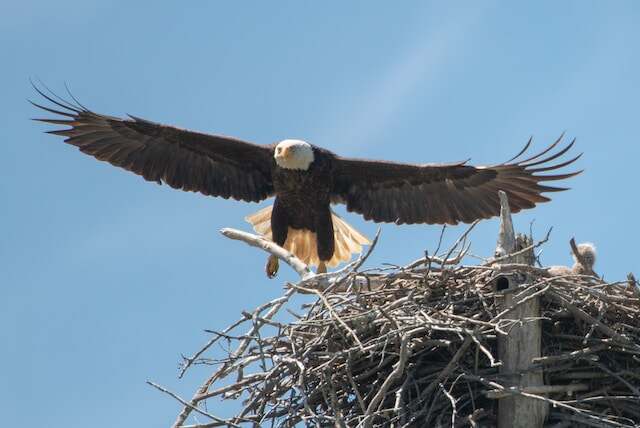
Long-term Survival and Reproduction
Juvenile dispersal plays a crucial role in the long-term survival and reproduction of eagles. Once the young eagles leave the nest, they embark on a journey to find their own territories and mates.
This dispersal behavior reduces competition within the family group and ensures genetic diversity within the population.
The success of juvenile dispersal can determine the future of eagle populations, as it allows for the establishment of new breeding territories and the avoidance of inbreeding.
Long-term survival and reproduction are intimately linked, as eagles must not only find suitable habitats but also secure resources for themselves and their offspring.
Understanding the factors that influence the success of juvenile dispersal and subsequent survival and reproduction is crucial for the conservation and management of eagle populations.
Consequently, conservation efforts and future research should focus on identifying and protecting important dispersal corridors and maintaining suitable habitats for eagle populations.
Conservation Efforts and Future Research
Conservation efforts and future research should prioritize the identification and protection of key dispersal corridors and the maintenance of suitable habitats to ensure the long-term survival and genetic diversity of eagle populations.
These efforts are crucial as habitat loss, pollution, and climate change continue to threaten eagle populations worldwide.
Conservation organizations and researchers are working together to develop strategies that promote the conservation of eagles and their habitats.
This includes the establishment of protected areas, the implementation of sustainable land use practices, and the reduction of human disturbance in eagle nesting sites.
Future research should focus on understanding the specific habitat requirements and ecological needs of different eagle species, as well as studying the impacts of climate change on their populations.
Additionally, it is essential to investigate the effectiveness of conservation interventions and adapt strategies accordingly.
By prioritizing conservation efforts and investing in future research, we can ensure the continued existence of these majestic birds for generations to come.
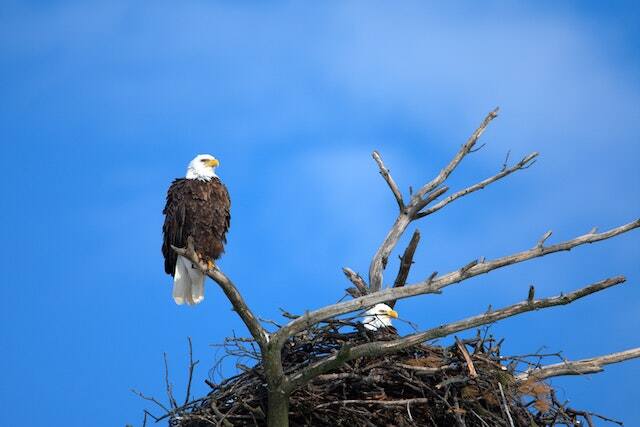
Frequently Asked Questions
How long does it take for eagle fledglings to become fully independent?
Eagle fledglings typically become fully independent within 10-12 weeks after hatching. During this period, they undergo behavioral changes, such as developing flight skills and hunting abilities. The survival rate of eagle fledglings largely depends on their ability to acquire essential skills for survival.
Do eagle parents continue to feed their young after they leave the nest?
Eagle parenting habits during the transition to independence are a subject of interest. Research has shown that eagle parents continue to provide food for their young even after they leave the nest, ensuring their offspring’s nourishment and successful development.
What factors determine when eagle parents stop feeding their young?
Factors influencing feeding cessation in eagle parents include the fledgling’s ability to hunt, obtain food independently, and reach a certain level of maturity. The impact of parental feeding on fledgling survival is significant, as it enhances their growth and development.
How do eagle fledglings learn to hunt and catch their own prey?
“Eagle fledglings learn to hunt and catch their own prey through a combination of instinct and observational learning. They observe their parents’ hunting techniques and gradually develop their own skills in capturing food.”
Are there any conservation efforts in place to protect eagle fledglings and their habitats?
Conservation efforts and protection measures are being implemented to safeguard eagle fledglings and their habitats. These initiatives aim to ensure the long-term survival of the species by addressing threats such as habitat loss, pollution, and illegal hunting.

